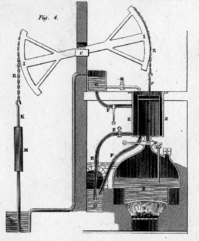 When Thomas Newcomen pumped water out of an English Coal Mine with a makeshift steam engine for the first time in 1722, little did he know that he was giving birth to the defining characteristic of industrial capitalism for the next two centuries--the relentless quest for greater labor productivity. By substituting coal for manpower, the English textile industry drove the industrial revolution and established the template--and "rules of the game"-- for all industrial enterprises to come. From cars to chemicals to computer chips, the very concept of "productivity" came to mean producing more product with fewer person-hours of work.
When Thomas Newcomen pumped water out of an English Coal Mine with a makeshift steam engine for the first time in 1722, little did he know that he was giving birth to the defining characteristic of industrial capitalism for the next two centuries--the relentless quest for greater labor productivity. By substituting coal for manpower, the English textile industry drove the industrial revolution and established the template--and "rules of the game"-- for all industrial enterprises to come. From cars to chemicals to computer chips, the very concept of "productivity" came to mean producing more product with fewer person-hours of work.This metric made sense in the 19th century, when coal (and other raw materials) were plentiful and people were relatively scarce. Now, however, exactly the reverse logic applies--fossil fuels and other raw materials are increasingly scarce and people are relatively plentiful. We now live with the paradox that increasing business productivity means fewer jobs (especially when economic growth slows), precisely at the time that we need productive employment the most.
Occupy Wall Street, the Arab Spring, the corruption crisis in India, the rural revolt in China--all of these growing social protest movements originate from the same source--a growing "opportunity crisis" driven by unemployment, underemployment, alienation, and humiliation. The time has come, therefore, to overthrow the tyranny of labor productivity and graduate to a new definition for what it means to be "productive" in business.
 In the emerging economies of the world, this revolution has already begun. ITC in India, for example, prides itself on creating livelihoods for the poor in the rural areas as part of its strategy for wasteland reforestation and agricultural productivity improvement. Indeed, as commodity costs rise, it may make sense to redefine productivity--from capital intensity and labor efficiency to labor intensity and capital efficiency. In the 21st century, "sustainable" enterprise must define success by the extent to which they create productive and fulfilling employment for the people of the world.
In the emerging economies of the world, this revolution has already begun. ITC in India, for example, prides itself on creating livelihoods for the poor in the rural areas as part of its strategy for wasteland reforestation and agricultural productivity improvement. Indeed, as commodity costs rise, it may make sense to redefine productivity--from capital intensity and labor efficiency to labor intensity and capital efficiency. In the 21st century, "sustainable" enterprise must define success by the extent to which they create productive and fulfilling employment for the people of the world. Is business up the challenge?
Stu,
Glad to see some excellent blogs here. I agree with your comments above regarding labor intensity. Can you point me to other material on this concept (one that I also have been thinking about for a while)? Are there companies that we can compare based on financial results AND on labor intensity? i.e. companies that produce similar products but have dissimilar labor intensity, which we can then compare on financial performance?
Keep up the good work!
Best,
Hewson